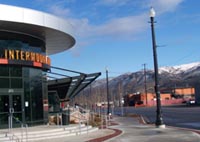Not long before she died earlier this month Molly Ivins, the great Texas political columnist, noted that the conventional American news media had an odd business strategy: Giving customers less and less of an ever duller and out of touch product. Newspaper readership has been declining since its peak in 1992. Now, instead of individual papers going out of business, entire chains are biting it. Almost a year ago Knight Ridder, which had squeezed the intellectual energy out of Pulitzer Prize winners in Miami, Philadelphia, and San Jose, sold all of its holdings to McClatchy.Â
The other side of this story, though, is the rise of independent news rooms on the Internet. They are taking many forms. Yet one of the most intriguing at the moment is the place-based blogs that are telling very different narratives about their communities, and attracting growing audiences. The place bloggers tend to be more immediate, interested in much more detail, less inclined to point cynical fingers, and much readier to probe and keep probing. Here’s a good example from Watertown, Mass.
I’m interested because one of those narratives is the Mode Shift that is the focus of this blog, the emergence of a new green, clean, energy efficient metropolitan development strategy. The new economic model is yielding authentic benefits for residents, businesses, and regions. Salt Lake City, for instance, built a LEED-certified energy-efficient Intermodal transit station (see pix) to serve as the hub of its 145-mile regional light rail and commuter rail system that is reshaping development patterns in one of the fastest growing metropolitan regions in the United States. Â
 A great example of how these old media/new media trend lines cross is now occurring in Detroit. If you happen to read the Detroit Free Press or the Detroit News, southeast Michigan’s two dailies, it’s like following an on-going regional funeral, and not only because of unrelenting bad news from the auto industry. The papers don’t appear terribly interested in digging out the new narratives of entrepreneurial activity in any sphere. I’ve worked for years in Detroit and know 50 great stories about terrifically dedicated people in business, government, law, academia, institutions, philanthropy and the non-profit sector whose work is making a huge difference.Â
A great example of how these old media/new media trend lines cross is now occurring in Detroit. If you happen to read the Detroit Free Press or the Detroit News, southeast Michigan’s two dailies, it’s like following an on-going regional funeral, and not only because of unrelenting bad news from the auto industry. The papers don’t appear terribly interested in digging out the new narratives of entrepreneurial activity in any sphere. I’ve worked for years in Detroit and know 50 great stories about terrifically dedicated people in business, government, law, academia, institutions, philanthropy and the non-profit sector whose work is making a huge difference.Â
You’ll find some of those people, though, in Model D, a blog launched in July 2005 that looks at political issues, social and economic trends, real estate news, and the people involved in finely hewn and intelligent journalism.  Yesterday’s edition had a very solid profile of Bruce Katz, the director of the Brookings Institution’s Metropolitan Policy Program, and one of the important researchers and strategists in American metropolitan affairs. Bruce’s group produced the Charting Maine’s Future report mentioned earlier this month in Mode Shift.Â
Bruce has been involved for several years in conducting research and shaping the various strategies Detroit could embrace to improve its well-being. The Model D piece is the best treatment of him and his work I’ve read in any Detroit media. Model D’s journalism falls into the realm of “appreciative inquiry,” which is a new school of reporting that is much less cynical than the frame of the conventional media. Model D’s report highlights the promising business trends that are shaping what Detroit is now and will be in 25 years.  Â
The transformation of metropolitan regions in the United States into places worthy of attention and investment, places that attract the brightest minds and best companies, hasn’t received nearly the focused conventional media treatment it deserves. I’m in Salt Lake City this week, one of the greenest, most energy efficient, politically progressive cities in the United States . It has received scant attention for its good work.
One important reason this is so is that the American Mode Shift is essentially a story of change based on collaboration and optimism. It’s not a story of conflict, not about bad news. And because it isn’t, it violates one of the basic tenets of conventional American journalism.
Jeremiah Owyang, the director of corporate media strategy at Podtech.net and one of the astute observers of social media, attended the WeMedia conference in Miami earlier this month and reported in his blog on the dynamic tension between the conventional media and the new Internet media. That growing and fractious distance is due to the speed of technological change and practices that has influenced where readers and viewers are found now. It’s also due to how the old media look at and cover the world. See Jeremiah’s postings from February 10, 2007.
One important reason this is so is that the American Mode Shift is essentially a story of change based on collaboration and optimism. It’s not a story of conflict, not about bad news.
I would say that’s a pretty succinct summing up of the differences, Keith. Nice piece, and Issues Media is doing great work telling the stories of entrepreneurs all over the state.
Andy, right on. Look for more out of Mode Shift. Keith
Great site. Verry usefull information.
Jamirkuai
Jamirkuai,
Tell all your friends. Audience is good. In April nearly 2,000 visitors to the site, and several dozen from Europe, Asia, and Australia. Mode Shift had 600 return visitors in April, the rest new visitors. For a just-launched blog, not bad. Keith